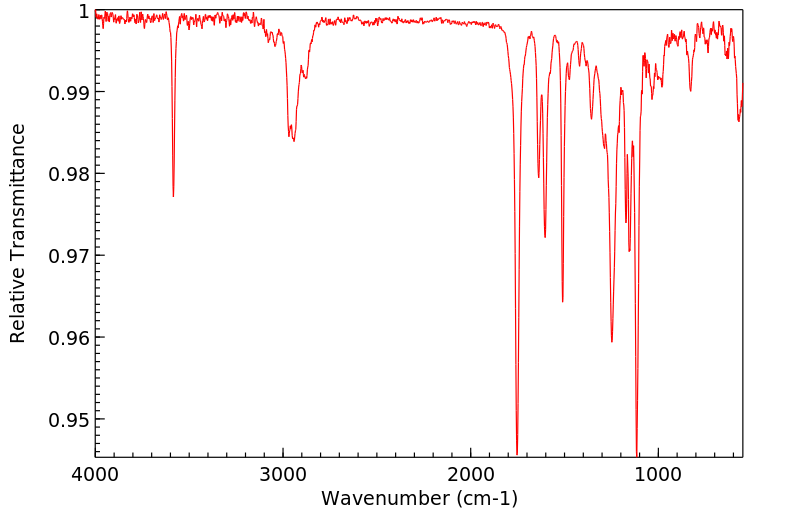4-戊氧基肉桂酸 | 62718-63-2
中文名称
4-戊氧基肉桂酸
中文别名
3-(4-戊氧基苯基)-2-丙酸
英文名称
4-pentyloxy-trans-cinnamic acid
英文别名
4-Pentyloxy-trans-zimtsaeure;p-Pentyloxycinnamic acid;(E)-3-(4-pentoxyphenyl)prop-2-enoic acid
CAS
62718-63-2
化学式
C14H18O3
mdl
MFCD00037797
分子量
234.295
InChiKey
WXPBGFBUVHLMSK-JXMROGBWSA-N
BEILSTEIN
——
EINECS
——
-
物化性质
-
计算性质
-
ADMET
-
安全信息
-
SDS
-
制备方法与用途
-
上下游信息
-
文献信息
-
表征谱图
-
同类化合物
-
相关功能分类
-
相关结构分类
物化性质
-
熔点:138-145 °C
-
沸点:389℃
-
密度:1.089
-
闪点:144℃
-
稳定性/保质期:
遵照规定使用和储存,则不会分解。
计算性质
-
辛醇/水分配系数(LogP):3.6
-
重原子数:17
-
可旋转键数:7
-
环数:1.0
-
sp3杂化的碳原子比例:0.357
-
拓扑面积:46.5
-
氢给体数:1
-
氢受体数:3
安全信息
-
危险品标志:Xi
-
危险类别码:R36/37/38
-
海关编码:2918990090
-
安全说明:S26,S37/39
-
储存条件:存放于阴凉干燥处。
SDS
| Name: | 4-Amyloxycinnamic Acid Material Safety Data Sheet |
| Synonym: | None Known |
| CAS: | 62718-63-2 |
Synonym:None Known
Section 2 - COMPOSITION, INFORMATION ON INGREDIENTS
| CAS# | Chemical Name | content | EINECS# |
| 62718-63-2 | 4-Amyloxycinnamic Acid | ca. 100 | unlisted |
Risk Phrases: 36/37/38
Section 3 - HAZARDS IDENTIFICATION
EMERGENCY OVERVIEW
Irritating to eyes, respiratory system and skin.
Potential Health Effects
Eye:
Causes eye irritation. May cause chemical conjunctivitis.
Skin:
Causes skin irritation.
Ingestion:
May cause gastrointestinal irritation with nausea, vomiting and diarrhea. The toxicological properties of this substance have not been fully investigated.
Inhalation:
Causes respiratory tract irritation. The toxicological properties of this substance have not been fully investigated. Can produce delayed pulmonary edema.
Chronic:
Effects may be delayed.
Section 4 - FIRST AID MEASURES
Eyes: Immediately flush eyes with plenty of water for at least 15 minutes, occasionally lifting the upper and lower eyelids. Get medical aid.
Skin:
Get medical aid. Flush skin with plenty of water for at least 15 minutes while removing contaminated clothing and shoes. Wash clothing before reuse.
Ingestion:
Never give anything by mouth to an unconscious person. Get medical aid. Do NOT induce vomiting. If conscious and alert, rinse mouth and drink 2-4 cupfuls of milk or water. Wash mouth out with water.
Inhalation:
Remove from exposure and move to fresh air immediately. If not breathing, give artificial respiration. If breathing is difficult, give oxygen. Get medical aid. Do NOT use mouth-to-mouth resuscitation.
Notes to Physician:
Treat symptomatically and supportively.
Section 5 - FIRE FIGHTING MEASURES
General Information:
As in any fire, wear a self-contained breathing apparatus in pressure-demand, MSHA/NIOSH (approved or equivalent), and full protective gear. During a fire, irritating and highly toxic gases may be generated by thermal decomposition or combustion.
Extinguishing Media:
Use water spray, dry chemical, carbon dioxide, or chemical foam.
Section 6 - ACCIDENTAL RELEASE MEASURES
General Information: Use proper personal protective equipment as indicated in Section 8.
Spills/Leaks:
Vacuum or sweep up material and place into a suitable disposal container. Clean up spills immediately, observing precautions in the Protective Equipment section. Avoid generating dusty conditions.
Provide ventilation.
Section 7 - HANDLING and STORAGE
Handling:
Minimize dust generation and accumulation. Avoid breathing dust, vapor, mist, or gas. Avoid contact with eyes, skin, and clothing.
Keep container tightly closed. Avoid ingestion and inhalation. Use with adequate ventilation. Wash clothing before reuse.
Storage:
Store in a tightly closed container. Store in a cool, dry, well-ventilated area away from incompatible substances.
Section 8 - EXPOSURE CONTROLS, PERSONAL PROTECTION
Engineering Controls:
Facilities storing or utilizing this material should be equipped with an eyewash facility and a safety shower. Use adequate ventilation to keep airborne concentrations low.
Exposure Limits CAS# 62718-63-2: Personal Protective Equipment Eyes: Wear appropriate protective eyeglasses or chemical safety goggles as described by OSHA's eye and face protection regulations in 29 CFR 1910.133 or European Standard EN166.
Skin:
Wear appropriate protective gloves to prevent skin exposure.
Clothing:
Wear appropriate protective clothing to prevent skin exposure.
Respirators:
Follow the OSHA respirator regulations found in 29 CFR 1910.134 or European Standard EN 149. Use a NIOSH/MSHA or European Standard EN 149 approved respirator if exposure limits are exceeded or if irritation or other symptoms are experienced.
Section 9 - PHYSICAL AND CHEMICAL PROPERTIES
Physical State: Solid
Color: Not available.
Odor: Not available.
pH: Not available.
Vapor Pressure: Not available.
Viscosity: Not available.
Boiling Point: Not available.
Freezing/Melting Point: Not available.
Autoignition Temperature: Not available.
Flash Point: Not available.
Explosion Limits, lower: Not available.
Explosion Limits, upper: Not available.
Decomposition Temperature:
Solubility in water:
Specific Gravity/Density:
Molecular Formula: C14H18O3
Molecular Weight: 234.1242
Section 10 - STABILITY AND REACTIVITY
Chemical Stability:
Stable at room temperature in closed containers under normal storage and handling conditions.
Conditions to Avoid:
Incompatible materials, dust generation, excess heat.
Incompatibilities with Other Materials:
Oxidizing agents.
Hazardous Decomposition Products:
Carbon monoxide, carbon dioxide.
Hazardous Polymerization: Will not occur.
Section 11 - TOXICOLOGICAL INFORMATION
RTECS#:
CAS# 62718-63-2 unlisted.
LD50/LC50:
Not available.
Carcinogenicity:
4-Amyloxycinnamic Acid - Not listed by ACGIH, IARC, or NTP.
Section 12 - ECOLOGICAL INFORMATION
Section 13 - DISPOSAL CONSIDERATIONS
Dispose of in a manner consistent with federal, state, and local regulations.
Section 14 - TRANSPORT INFORMATION
IATA
Not regulated as a hazardous material.
IMO
Not regulated as a hazardous material.
RID/ADR
Not regulated as a hazardous material.
Section 15 - REGULATORY INFORMATION
European/International Regulations
European Labeling in Accordance with EC Directives
Hazard Symbols: XI
Risk Phrases:
R 36/37/38 Irritating to eyes, respiratory system
and skin.
Safety Phrases:
S 26 In case of contact with eyes, rinse immediately
with plenty of water and seek medical advice.
S 37/39 Wear suitable gloves and eye/face
protection.
WGK (Water Danger/Protection)
CAS# 62718-63-2: No information available.
Canada
None of the chemicals in this product are listed on the DSL/NDSL list.
CAS# 62718-63-2 is not listed on Canada's Ingredient Disclosure List.
US FEDERAL
TSCA
CAS# 62718-63-2 is not listed on the TSCA inventory.
It is for research and development use only.
SECTION 16 - ADDITIONAL INFORMATION
N/A
上下游信息
-
上游原料
中文名称 英文名称 CAS号 化学式 分子量 —— (E)-3-(4-Pentyloxy-phenyl)-acrylic acid methyl ester 99196-56-2 C15H20O3 248.322 4-香豆酸 p-Coumaric Acid 501-98-4 C9H8O3 164.161 —— methyl 4-hydroxycinnamate 3943-97-3 C10H10O3 178.188 4-正戊氧基苯甲醛 4-(n-pentyloxy)benzaldehyde 5736-91-4 C12H16O2 192.258 -
下游产品
中文名称 英文名称 CAS号 化学式 分子量 —— trans-p-pentyloxycinnamoyl chloride 77251-78-6 C14H17ClO2 252.741
反应信息
-
作为反应物:描述:参考文献:名称:新型乙烯衍生物的合成及液晶性质摘要:合成了一系列新型液晶,即α-4-[4'-n-烷氧基肉桂酰氧基]苯甲酰基-β-4″-氯苯基乙烯。该系列由十二个同系物组成。甲基到丁基的衍生物不是液晶,其余的同系物是对映液晶。该系列的辛基至十二烷基衍生物除了具有致线虫的特性外,还具有对映性近晶化,但该系列的戊基、己基、庚基十四烷基和十六烷基同系物仅具有致线虫性,不显示近晶相。新物质的转变温度是通过配备加热台的光学偏光显微镜测定的。转变温度与正烷氧基末端链中存在的碳原子数的关系图代表了该系列的相行为。对于向列-各向同性转变曲线,观察到奇偶效应。向列相的织构为螺纹或纹影型,近晶 A 和近晶 C 相的织构是典型的。分析和光谱数据与分子结构一致。近晶和向列热稳定性分别为 132.6°C 和 156.7°C。近晶相从辛氧基同系物开始。近亲相长度从 26°C 到 33°C 不等,生线虫相长度从 6°C 到 70°C 不等。该系列主要是生线虫,部分是近生的DOI:10.1080/15421406.2013.781491
-
作为产物:描述:methyl 4-hydroxycinnamate 在 sodium hydride 作用下, 反应 4.0h, 生成 4-戊氧基肉桂酸参考文献:名称:新的有效的白三烯C4和D4拮抗剂。1.合成与构效关系。摘要:(p-戊基肉桂酰基)邻氨基苯甲酸(3a)对LTD4-诱导的豚鼠回肠平滑肌收缩和LTC4诱导的豚鼠支气管收缩具有中等程度的拮抗活性。对3a的疏水部分(肉桂酰基部分)和亲水部分(邻氨基苯甲酸酯部分)进行了修饰。揭示了一系列的8-(苯甲酰基氨基)-2-四唑-5-基-1,4-苯并二恶烷和8-(苯甲酰基氨基)-2-四唑-5-基-4-氧代-4H-1-苯并吡喃。白三烯C4和D4的有效拮抗剂。在这两个系列中,ONO-RS-347(18k)和ONO-RS-411(19h)分别是最有效和口服活性的拮抗剂。讨论了构效关系。DOI:10.1021/jm00396a013
文献信息
-
Synthetic pathway for a new calamitic series of liquid crystal: Comparison with corresponding linkage group作者:Vinay S. Sharma、Rajesh H. Vekariya、Anuj S. Sharma、R. B. PatelDOI:10.1080/15421406.2017.1370957日期:2017.7.24GRAPHICAL ABSTRACT ABSTRACT Two homologous series based on three linking groups have been synthesized and characterized by elemental analyses and spectroscopic techniques such as Fourier transform infrared [FT-IR] and protonmagnetic resonance magnetic resonance [1H-NMR] spectroscopy. The mesomorphic properties of these compounds were observed by optical polarized light microscopy (POM) and differential图形摘要 摘要 合成了基于三个连接基团的两个同源系列,并通过元素分析和光谱技术(如傅里叶变换红外 [FT-IR] 和质子磁共振磁共振 [1H-NMR] 光谱)表征。通过偏振光显微镜(POM)和差示扫描量热法(DSC)观察这些化合物的介晶性质。在本次调查中,我们合成了两个同源系列,即。4-(3-oxo-3-(4-((-3-phenylallylidene) 氨基) 苯基)prop-1-en-1-yl) 苯基 4-n-烷氧基苯甲酸酯) (series-1) 和 4-( 3-oxo-3-(4-((-3-phenylallylidene) 氨基) 苯基) prop-1-en-1-yl) 苯基 3-(4-n-烷氧基苯基) 丙烯酸酯 (series-2)。这两个系列的不同之处在于第一个连接基团。
-
Study the effects of terminal side chain and –nitro group on mesomorphic behaviour of cinnamate-chalconyl based liquid crystal作者:Vinay S. Sharma、R. B. PatelDOI:10.1080/15421406.2016.1262672日期:2017.1.22GRAPHICAL ABSTRACT ABSTRACT The influence of the terminal side chain and lateral nitro on mesomorphism due to the flexibility and polarity of lateral group is investigated. A new homologues series is synthesized to accomplish this aim. The C1 to C3 homologue are nonmesomorphic, while the rest of the homologues exhibit enantiotropic nematic and smectic properties. The texture of the nematic mesophase图形摘要 摘要 由于侧基的柔性和极性,研究了末端侧链和侧硝基对介晶的影响。合成了一个新的同系物系列来实现这一目标。C1 到 C3 同系物是非介晶的,而其余同系物则表现出对映向列和近晶特性。向列中间相的织构为螺纹、纹影和液滴型。所有这些化合物都通过元素分析和 FTIR 和 1 H 核磁共振 (NMR) 的光谱技术表征。通过偏光显微镜 (POM)、差示扫描量热法 (DSC) 和 X 射线衍射技术研究相行为。
-
Mesomorphism dependence on central bridges and the efficiency order of the tail group作者:G. N. Bhola、U. C. BhoyaDOI:10.1080/15421406.2016.1146937日期:2016.5.2ABSTRACT A novel homologous series: RO-C6H4‒CH˭CH‒COO‒C6H4‒CH˭N-C6H3 (CH3)2 of ortho-meta Schiff's bases has been synthesized and studied with a view to understanding and establishing the effects of molecular structure on mesomorphic properties and to provide a source of novel liquid crystalline (LC) materials. The series consists of 13 homologues (C1 to C8, C10, C12, C14, C16 & C18). C1 and C3 homologues摘要 合成并研究了一个新的同源系列:RO-C6H4-CH˭CH-COO- -CH˭N-C6H3 (CH3)2 的邻位希夫碱,以了解和建立分子结构的影响介晶特性,并提供新型液晶 (LC) 材料的来源。该系列由 13 个同源物(C1 到 C8、C10、C12、C14、C16 和 C18)组成。C1 和 C3 同系物是非介晶的,C2 和 C4 单向性的,C6 和 C7 单向性的和对映性的,C5 仅是对映性的,C8、C10、C12 是对映性的近向性加线虫的,C14、C16 仅是对映性的。使用配备加热台的光学偏光显微镜测定纹理和转变温度。分析和光谱数据证实了分子结构。平均近晶和向列热稳定性分别为 100.16°C 和 110.83°C。将当前新系列的介晶特性与结构相似的同源系列进行比较。
-
Molecular flexibility dependence on mesogenic behaviors of isomeric and nonisomeric series作者:P. K. Rakhasia、Avani R. Ranchchh、U. C. BhoyaDOI:10.1080/15421406.2016.1263119日期:2017.1.22determined using an optical polarizing microscope equipped with a heating stage (POM). The textures of a nematic phase are threaded or Schlieren and that of a smectic phase are of the A or C type. Analytical, thermal and spectral data support the molecular structures. Smectic and nematic thermal stabilities are 116.85°C and 147.5°C, respectively. Whose Sm‒N/I and N-I mesophase lengths are varied between摘要 包含乙烯基酯和偶氮甲烷中心桥和正烷氧基以及 3",4"-二甲基作为柔性末端/侧基的新型同源系列,即。RO-C6H4-CH = CH-COO- -N˭CH-C6H3-(CH3)2 已被合成和研究,以建立分子结构与热致液晶(LC)特性之间的关系,并参考分子的柔韧性系列内。该系列由十二个同源物(C1 到 C16)组成。C6 和 C7 同源物是近亲和线虫的,C8 到 C16 同源物仅是近亲的,其余的同源物(C1 到 C5)是非中胚层的。使用配备加热台 (POM) 的光学偏光显微镜测定转变温度和同系物的质地。向列相的织构为螺纹或纹影,近晶相的织构为 A 或 C 型。分析、热和光谱数据支持分子结构。近晶和向列热稳定性分别为 116.85°C 和 147.5°C。其 Sm-N/I 和 NI 中间相长度分别在 15°C 至 21°C 和 25°C 至 62°C 之间变化。将新化合物与结构相似的系列进行比较。
-
“Dependence of Mesomorphism in Combination with Fluoro and Chloro Groups”作者:Avani R. Ranchchh、Bhavna R. Tharesha、U.C. BhoyaDOI:10.1080/15421406.2019.1624034日期:2018.11.2Abstract A novel azoester homologous series with chloro lateral group and a fluoro terminal end group was synthesized and characterized for mesomorphic properties. It consists of thirteen azo ester derivatives from trans-4-n-alkoxy cinnamic acid with 4-hydroxy-3-chloro phenyl azo-3-chloro-4-fluoro benzene. Mesomorphic property commences from C4homologue as smectic.C1 to C3 member of the series are摘要 合成了一种具有氯侧基和氟端基的新型偶氮酯同源系列,并对其介晶性质进行了表征。它由来自反式-4-n-烷氧基肉桂酸与 4-羟基-3-氯苯基偶氮-3-氯-4-氟苯的十三种偶氮酯衍生物组成。介晶性质从 C4 同系物作为近晶开始。该系列的 C1 到 C3 成员是非介晶的。C4 至 C18 同源是对映近晶 A 相。向列中间相完全不存在。同系物的质地和转变温度由配备加热台的光学偏光显微镜确定。包括一些成员的 1H NMR、IR 光谱、质谱。光谱分析支持分子结构。相图用于说明整个系列的介晶行为。近晶相的中间相长度在 18.0°C 到 69.00C 之间变化。将新型偶氮酯系列的介晶性质与结构相似的系列进行比较。
表征谱图
-
氢谱1HNMR
-
质谱MS
-
碳谱13CNMR
-
红外IR
-
拉曼Raman
-
峰位数据
-
峰位匹配
-
表征信息
同类化合物
(E)-3-(4-(叔丁基)苯基)丙烯酸乙酯
(E)-3-(2-(三氟甲基)苯基)丙烯酸乙酯
(E)-3-(2,4-二甲氧基苯基)丙烯酸乙酯
(2E)-N-[2-(3-羟基-2-氧代-2,3-二氢-1H-吲哚-3-基)乙基]-3-苯基丙-2-烯酰胺
黄金树苷
鲁索曲波帕
香豆酸肉桂酯
香豆酰多巴胺
香草醛缩丙酮
顺式邻羟基肉桂酸
顺式芥子酸
顺式-曲尼司特
顺式-乙基肉桂酸酯
顺式-N-阿魏酰酪胺
顺式-3,4-二甲氧基苯丙烯酸
顺式-2-((叔丁氧羰基)氨基)-3-(4-氨甲酰基-2,6-二甲苯基)丙烯酸甲酯
顺-o-羧基肉桂酸
顺-2-甲氧基肉桂酸
阿魏酸钠
阿魏酸酰胺
阿魏酸甲酯
阿魏酸甲酯
阿魏酸甲酯
阿魏酸松柏酯
阿魏酸杂质1
阿魏酸异辛酯
阿魏酸哌嗪
阿魏酸二十烷基酯
阿魏酸乙酯
阿魏酸4-O-硫酸二钠盐
阿魏酸-D3
阿魏酸
阿魏酸
阿魏酰酪胺
间羟基肉桂酸
间羟基肉桂酸
间硝基肉桂酸
间甲基肉桂酸
间甲基反式肉桂酸甲酯
间氯肉桂酸
间三氟甲氧基肉桂酸甲酯
间-香豆酸
间-(三氟甲基)-肉桂酸
锂(E)-2-溴-3-苯基丙烯酸酯
钠二乙基2-[(氧代氨基)-苯基亚甲基]丙二酸酯盐
酪氨酸磷酸化抑制剂AG 556
酪氨酸磷酸化抑制剂AG 527
酪氨酸磷酸化抑制剂AG 490
酪氨酸磷酸化抑制剂A46
酪氨酸磷酸化抑制剂 AG 30








